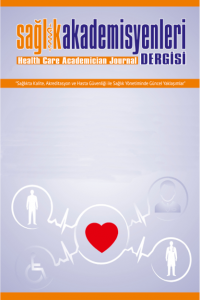HIPAA standartları açısından elektronik sağlık kayıtlarının güvenlik ve mahremiyet uygulamaları: Türkiye’de bir vaka çalışması
HIPAA, Sağlık Bilgi Sistemleri, Bilgi Güvenliği, Elektronik Sağlık Kayıtları, Mahremiyet, HIPAA
Security and privacy practices of electronic health records in terms of HIPAA standards: A case study in Turkey
Health Information Systems, Information Security, Electronic Health Records, Privacy, HIPAA,
___
- Ajami S, Bagheri-Tadi T. Barriers for Adopting Electronic Health Records (EHRs) by Physicians, Acta Informatica Medica, 2013, 21(2): 129-134
- Aksu Kılıç P, Kitapçı Şişman N, Çatar R. Ö, Köksal L, Mumcu G. An Evaluation of Information Security from the Users’ Perspective in Turkey. Journal of Health Informatics in Devoloping Countries, 2015, 9(2): 55-67
- Aldosari B. Causes of EHR Projects Stalling or Failing: A Study of EHR Projects in Saudi Arabia, Computers in Biology and Medicine, 2017, 91: 372-381.
- Bohu Y, Klouche S, Lefevre N, Webster K, Herman S. Translation, Cross-Cultural Adaptation and Validation of the French Version of The Anterior Cruciate Ligament-Return to Sport After Injury Scale, Knee Surg. Sports Traumatol Arthrosc., 2015, 23: 1192-1196.
- Chen Q, Benusa A. HIPAA Security Compliance Challenges: The Case for Small Healthcare Providers, International Journal of Healthcare Management, 2017, 10 (2): 135-146
- Cronbach L. Coefficient Alpha and The Internal Structure of Test, Psychometrika, 1951, 16(3): 297-334.
- Çınaroğlu S, Avcı K. Comparison of Asessments of Medical and Surgical Nurses About Usage of Electronic Health Records, TAF Preventive Medicine Bulletin, 2015, 14 (3): 257-264.
- Forcepoint, Industry Drill-Down Report Healthcare, 2015. www.insight.com/content/dam/insight-web/en_US/article-images/ebooks/Partner/2015-industry-drill-down-report-healthcare.pdf
- Hartley C, Jones E. EHR Implementation: A Step-by-Step Guide for the Medical Practice, American Medical Association, 2th Edition, Chicago, 2012.
- Kohli R, Tan S. Electronıc Health Records: How Can Is Researchers Contrıbute To Transformıng Healthcare?, MIS Quarterly, 2016, 40(3): 553-573.
- Lapke M, Garcia C, Henderson D. The Disconnect Between Healthcare Provider Tasks and Privacy Requirements, Health Policy and Technology, 2016, 1-8.
- Mishra S, Leone G, Caputo D, Calabrisi R. Securıty Awareness For Health Care Informatıon Systems: A HIPAA Compliance Perspective, Issues in Information Systems, 2011, 12(1):224-236.
- Liginlal D, Sim I, Khansa L, Fearn P. HIPAA Privacy Rule Compliance: An Interpretive Study Using Norman’s Action Theory, Computers & Security, 2012, 31: 206-220.
- Lukaschyk J, Brockmann-Bauser M, Beushausen U, Transcultural Adaptation and Validation of the German Version of the Vocal Tract Discomfort Scale, Journal of Voice, 2017, 31 (2): 261-268.
- Pham T. The Current State of Healthcare Endpoint Security, Industry News, 2016. Shahmoradi L, Darrudi A, Arji G, Nejad A. Electronic Health Record Implementation: A SWOT Analysis, Acta Medica Iranica, 2017, 55 (10): 642-649.
- Simon S, Kaushal R, Cleary P, Jenter C, Volk L, Poon E, Orav J, Lo H, Willıams D, Bates D,. Correlates of Electronic Health Record Adoption in Office Practices: A Statewide Survey, Journal of the American Medical Informatics Association, 2007, 14 (1): 110-117.
- Singh B. Nurse’s Attitude Towards Computerization in Private Hospitals of Tamil Nadu, India, Research J. Pharm. and Tech., 2016, 9 (12): 1451-1456.
- Vignola R, Tucci A. Adaptation And Validation of The Depression, Anxiety and Stress Scale to Brazilian Portuguese, Journal of Affective Disorders, 2014, 155: 104-109.
- ISSN: 2148-7472
- Yayın Aralığı: Yılda 4 Sayı
- Başlangıç: 2014
- Yayıncı: Dünya Kongre
Patoloji sonuçlarının zamanında çıkmasına yönelik kademeli SMS uygulamaları Dışkapı modeli
Elif Özyurt, Deniz Uğurlu, Seyhan Erduran, Metin Aykutluğ, Semih Dinçer Yetiş, İlhan Aydın, Yeşim Akar, Onur Açıkgöz, Murat Alper
Ali EKŞİ, Fulya Atalay Yalçın, Gülce Kirazlı, Ebru Kalyoncu, İsmail Cem Kantarlı
Türkiye’de sağlık sisteminin gelişiminin analizi
Ümit ÇIRAKLI, Hasan Hüseyin Yıldırım
Halk sağlığı bilgi kaynağı olarak gazeteler: Sağlıkla ilgili haberlerin analizi
Hasta mahremiyetinin değerlendirilmesi
Yeşim AKAR, Elif ÖZYURT, Seyhan ERDURAN, Deniz UĞURLU, İlhan AYDIN
Kişisel sağlık verilerinin hukuki korunması
Ankara’da yaşayan kişilerin özel sağlık sigortalarına ilişkin görüşlerinin değerlendirilmesi
Tanı ilişkili gruplara dayalı geri ödeme simülasyonu: Türkiye ve Avustralya karşılaştırması
